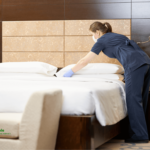In the journey of tenancy, the end of lease period marks a crucial phase where securing the full return of your bond becomes a primary concern. The bond, often equivalent to a month’s rent or more, is a significant amount that tenants eagerly anticipate recovering. This article delves into the pivotal role of end-of-lease cleaning in ensuring that you maximise your bond return, drawing upon current trends, statistics, and expert insights.
Understanding End of Lease Cleaning
End of lease cleaning, also known as bond cleaning, is a comprehensive cleaning process undertaken at the end of a rental agreement. It involves a thorough cleaning of the rental property, ensuring it is in the same condition as at the start of the lease, barring normal wear and tear. The standard for this cleaning is often higher than regular house cleaning, as it must pass the inspection of landlords or property managers.
The Importance of a Clean Slate
A study by the Tenants’ Union of Victoria found that cleaning issues were among the top reasons for bond deductions. This highlights the importance of impeccable cleaning in securing your bond. Landlords expect properties to be returned in a ‘rentable’ state, and any shortcomings in cleanliness can lead to deductions from the bond to cover the costs of additional cleaning or repairs.
DIY vs Professional Cleaning
When considering end-of-lease cleaning, tenants face the choice of doing it themselves or hiring professional cleaners. Each option has its merits and drawbacks. DIY cleaning can be more cost-effective and gives tenants complete control over the process. However, it can be time-consuming and stressful, especially without the right equipment or experience. On the other hand, professional cleaners offer expertise, efficiency, and a guarantee that cleaning standards will meet the landlord’s expectations.
In the context of whether to opt for DIY or professional cleaning, it’s essential to weigh the time, effort, and potential stress involved against the assurance and convenience provided by professional services. For an in-depth look at this decision, you might find our article on “End of Lease Cleaning: Do-It-Yourself or Hire Professionals” helpful, where we explore the pros and cons of each approach in detail.
Cleaning Checklist: A Room-by-Room Guide
A detailed cleaning checklist is vital. It should cover every room, including hidden areas like the tops of cabinets and under furniture. Key areas to focus on include:
- Kitchen: Deep clean appliances, cupboards, and counters.
- Bathroom: Sanitize toilets, showers, and sinks.
- Living Areas & Bedrooms: Dust, vacuum, and clean windows.
- Outdoor Areas: Tidy up gardens, patios, and balconies.
Eco-Friendly Cleaning Options
Sustainability in cleaning has gained traction recently. Eco-friendly cleaning products, which are less harmful to the environment and often safer for users, are an excellent choice for end-of-lease cleaning. They can be equally effective as chemical-based cleaners and are increasingly favoured by environmentally conscious landlords and tenants.
Tips for a Successful End of Lease Clean
- Start Early: Begin the cleaning process well before the lease ends to avoid last-minute rushes.
- Use a Checklist: Follow a comprehensive cleaning checklist to ensure no area is overlooked.
- Document Everything: Take before and after photos for proof of the property’s condition.
- Focus on High-Impact Areas: Pay extra attention to kitchens and bathrooms, as they are often scrutinised during inspections.
- Seek Professional Advice: If unsure, consult with cleaning professionals or your property manager.
The Financial Impact of End of Lease Cleaning
Investing in end-of-lease cleaning can have a significant return. According to a survey by the National Landlords Association, about 89% of disputes over deposit returns are related to cleaning. By ensuring a high standard of cleanliness, you greatly increase the likelihood of receiving your full bond back. The cost of professional cleaning services, which varies depending on the size and condition of the property, can be a worthwhile investment compared to the potential bond deductions for cleaning issues.
Conclusion
End of lease cleaning plays a crucial role in maximising your bond return. Whether you choose to do it yourself or hire professionals, the key is to ensure the property is returned in a condition that meets or exceeds the original state. By following a detailed cleaning checklist, considering eco-friendly options, and understanding the financial implications, tenants can significantly improve their chances of a full bond return. The effort and attention you put into end-of-lease cleaning can be the decisive factor in securing your financial investment and ensuring a smooth transition to your next home.






